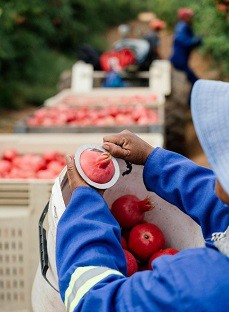 Due to heavy rain in December during the third flowering of pomegranates, fruit set was lower than normal and the pomegranate crop will be smaller this season, says the vice-chair of South Africa’s pomegranate grower association, POMASA.
Due to heavy rain in December during the third flowering of pomegranates, fruit set was lower than normal and the pomegranate crop will be smaller this season, says the vice-chair of South Africa’s pomegranate grower association, POMASA.
“I am expecting bigger fruit and good quality,” notes Christo Nortjé of the farm Blydeverwacht near Wellington.
Their early pomegranates Acco and Emek will start in week 7, and the season ends with the Wonderful variety by mid-April.
“We hope everything works out better this year with regards to logistics. Our advantage is that our pomegranates come in when grapes are finishing and before citrus starts, so the harbour isn’t that busy (not that that helped us during the past two seasons due to other influencing factors).”
They could theoretically stretch their pomegranate season with even later varieties like the Kingdom, but it will put pressure on the packhouses since it will overlap with the Western Cape’s citrus season.
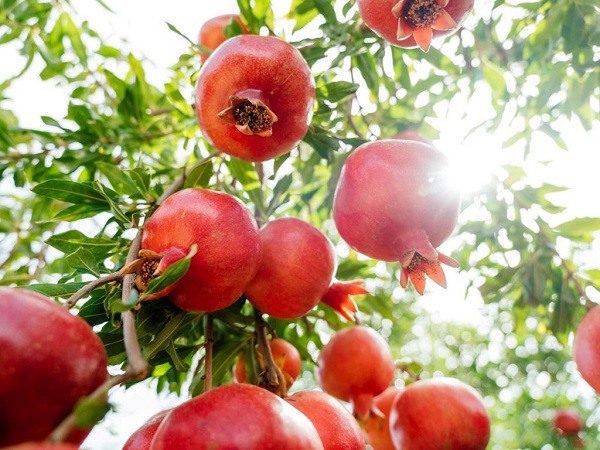
Middle East now takes over half South African pomegranates
South Africa’s total export of pomegranates lies between 6,500 to 8,000 tonnes grown on about 800 ha.
Europe used to take the majority of South Africa’s pomegranates but that figure is now roughly 30%, with 57% sent to the Middle East and the balance going to Africa, the Far East and Asia.
“On this farm we focus on the UK and the EU. With our early varieties we can squeeze into the period after Turkey and Israel and before Peru starts, when the market is empty. As the season progresses, our early varieties complete with Peru’s Wonderful coming into the markets. Once our Wonderful get to the market, Peru already has a significant presence.”
Over the past few years Peru has been pushing hard into Europe and as they came into Europe, Christo explains, South Africa has been moving more to the Middle East. He hopes that in future Peru will direct more of their volumes to China and North America, to give a bit more space for South African pomegranates in the EU.
South African pomegranates have very good internal quality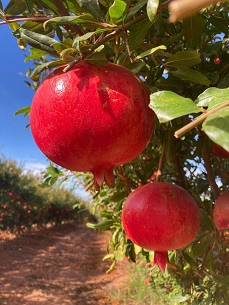 Harvested fruit is pre-sorted in the field and packed one by one into bins, never tipped, and taken to Sonlia fruit packhouse only 5km away, which packs most of South Africa’s pomegranates.
Harvested fruit is pre-sorted in the field and packed one by one into bins, never tipped, and taken to Sonlia fruit packhouse only 5km away, which packs most of South Africa’s pomegranates.
The market is adamant that it wants the Wonderful variety but when pomegranate supply is limited, they’ll take varieties like Acco (although its softer skin demands more careful removal of the arils), Emek and Herskovitz, all of which has very good internal colour.
“Since the markets prefer Wonderful, I sell my Acco pomegranates through having Wonderful as well,” he remarks.
South African pomegranate growers have no trouble with the colouring of these early varieties, but their shelf life is not as long as the later Wonderful. Significant logistical delays at the ports the last two seasons have caused quality problems on these early varieties.
Drive for cosmetic perfection drives significant food waste
However, Wonderful, sought-after as it is, presents some serious challenges to these growers.
“The external colour of our Wonderful pomegranates is not as red as Peru’s. We struggle with external colour while internally, it is already ripe and bloodred. If you wait too long for fruit to colour externally, it starts to crack as the fruit keeps growing. When you stand in the quiet orchard early in the morning or late afternoon," he says, "you can hear the fruit cracking."
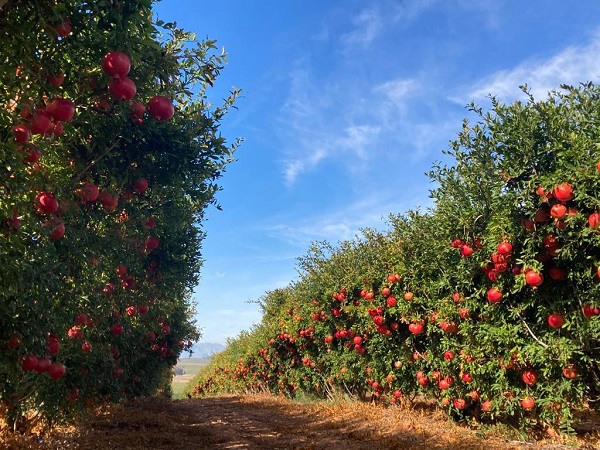
Their investigation into the problem hasn’t led them to a conclusive reason for the cracking which can also occur in the bin or during transport. Day and night temperature fluctuations and humidity have an effect on the cracking of fruit. Cold rain during thunderstorms on hot fruit is guaranteed to cause fruit to crack as well.
"Because of the demand for external color, we are only exporting about 28% of Class 1 Wonderful. At some point you just have to decide to stop waiting for colour and go in and harvest to prevent high losses due to cracking.”
He points out that they don’t have this problem with the Acco, Emek or Herskovitz varieties, but retailers insist on Wonderful pomegranates and consumers expect pomegranates that are externally bloodred.
“We are wasting very good fruit that eat well because of cosmetic expectations. Processing companies recognize that pomegranates don’t have to be bloodred with no marks on the skin. In fact,” he points out, “processing companies prefer South African pomegranates to Peruvian pomegranates because the pips are very red inside our fruit whereas Peru’s pips are not that red.”
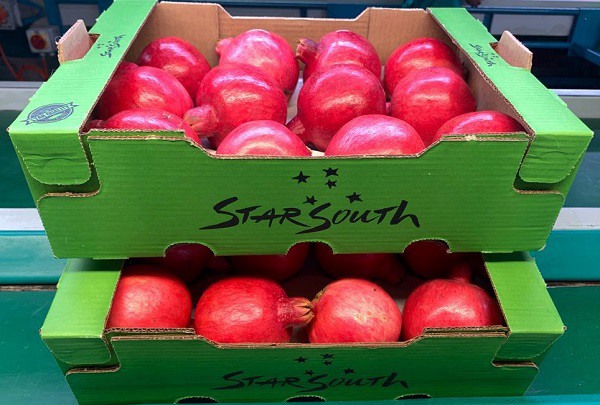
On the farm 22ha of pomegranates are grown and 30ha of wine grapes, but Christo readily foresees that they will have no more wine grapes by the end of the decade.
“If you have enough wine grapes and you can harvest it mechanically, it’s fine. We are not a big farm, so no. The problem is that pomegranates use more water than wine grapes. We have a quota out of the Berg River of 5,000 cubic metre water per ha. Wine grapes use about 4,000 cubic metre per hectare, whilst Acco and Emek use around 6,500 cubic metre per ha and Wonderful 8,000 cubic metre per ha."
He continues: "The reason for the higher water demand of Wonderful, is that the growing season is a month longer than the earlier varieties and being a high yielding crop, it has a higher water demand. Therefore we need 1.5ha of allocated water rights to irrigate 1 ha of pomegranates.”
Fortunately, Wonderful’s yield makes up for its other complexities: they get between 30 to 40 tonnes per hectare, compared to Acco with 25 tons and Emek at 30 tons.
Demand from processing sector grows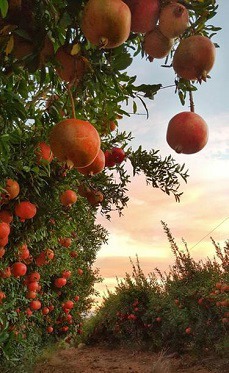 Over the past three years there hasn’t been an increase in the price levels of fresh fruit, all the while shipping and packaging costs are strongly rising – on packing materials alone, there’s been a 25% increase from last year.
Over the past three years there hasn’t been an increase in the price levels of fresh fruit, all the while shipping and packaging costs are strongly rising – on packing materials alone, there’s been a 25% increase from last year.
“The packing cost for processing is less than for Class 1 fruit: it’s packed into 15kg cartons compared to the 3.8kg Class 1 cartons. The cartons are a very big cost driver. If you only pack processing, the sorting cost in the packhouse is lower.
Blue Skies deseed pomegranates in South Africa and we also move our fruit through them. It’s a very good market because there are no shipping costs and no packing material costs.”
They also send pomegranates to processors in the UK, Ghana and Egypt.
South African retailers ride roughshod over pomegranates
The local market for pomegranates is small and pomegranates are offered to consumers at high prices.
“If retailers could bring prices down a bit it would help. It’s difficult to create demand at a price of R60 [3 euros] and even more per kilogram.”
He also feels that local retailers aren’t taking care of the fruit which the growers deliver to them with the utmost care.
“South African retailers are not looking after the pomegranates. If you look at how they handle it, how they pack it, the quality of fruit on the supermarket shelf – it’s not looking good.”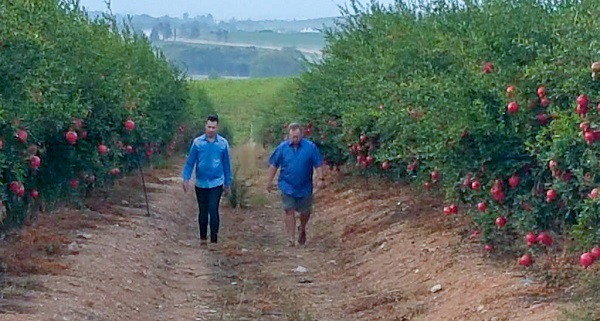 Christo Nortjé, right, with Herman Lensing, South African chef and food writer
Christo Nortjé, right, with Herman Lensing, South African chef and food writer
The packhouse is selling small pomegranates in punnets to retailers with pamphlets on how to open and eat pomegranates as a marketing tool to develop the local market.
“We have a good product, especially internally. We need to convince the market that not only Wonderful is a good pomegranate,” he says.
Elizabeth Nortjé remarks: “If you get the hang of opening a pomegranate it’s not messy and not so time consuming. I open it in water, to ensure the arils don’t break and spray. The arils freeze perfectly in glass containers."
She notes that she's always astonished to see the amount of arils in one fruit. "With the rich nutrient and antioxidant value of pomegranates, it is well worth the health investment to buy pomegranates, even during tough economic times.”
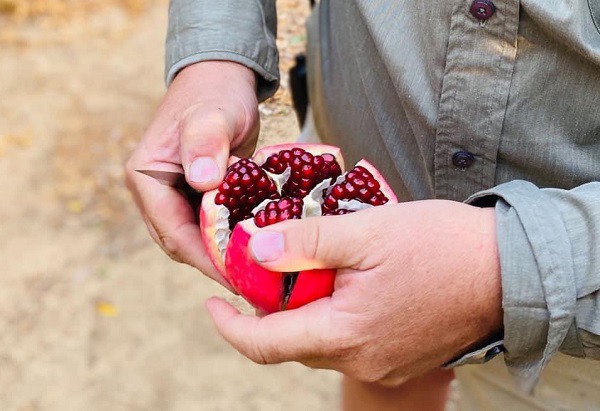 The right way to open a pomegranate, topped and segmented
The right way to open a pomegranate, topped and segmented
For more information:
Christo Nortjé
Blydeverwacht Pomegranates
Tel: +27 82 789 4037
Email: [email protected]
https://www.sapomegranate.co.za/
